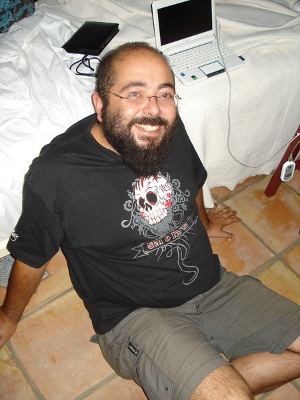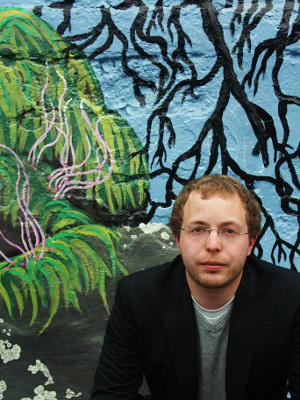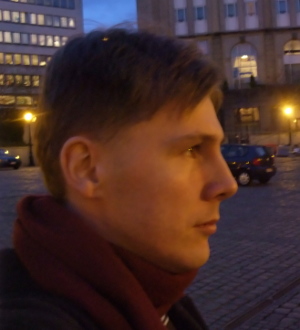David Reyes Samblas Martinez is the founder of Spanish Copyleft Hardware store Tuxbrain, and attended the famous Open University of Catalunya. He’s also the subject of this month’s Fellowship interview, in which he answers questions on hardware manufacturing, e-learning and Free Software politics.
Stian Rødven Eide: For well over a year, your main activity has been Tuxbrain, a shop dedicated to open, hackable devices, and, in particular, Copyleft hardware. Initially inspired by the community success of Openmoko, your selection has since grown to include several other products as well. Could you tell us a bit about how you came to start Tuxbrain, and how the first year has been?

David Reyes Samblas Martinez
David Reyes Samblas Martinez: My business partner Victor Remolina and I discovered the FOSS world about 7-8 years ago. Since then, we have always been thinking about doing something together around Free Software. When the name Tuxbrain first was mentioned about 5 years ago, we immediately decided that whatever we do has to carry that name. We soon created a manifesto outlining the philosophy of Tuxbrain. The main aspects of it were that the company should be integrated inside the FOSS community, be part of it, and dedicate part of its time and resources to help initiatives that we found interesting grow. We felt that this would help us grow as well.
When we discovered Openmoko, we were fascinated by the idea of the FOSS philosophy being ported to the hardware world. While software can be replicated ad infinitum with barely no cost, physical devices carry a huge cost even in the first draft. With Openomoko there was, for the first time as far as I know, information available on the design and production that could be shared and improved by the community – the same way software was. Lacking the distribution networks of larger manufacturers, Openmoko promoted the idea of group selling, where customers would share shipping costs and get volume discounts. I began organising a Spanish purchasers’ group, which soon was joined by Portugal as well, and that was how the first Openmokos arrived to the Iberian peninsula. It felt great making all those geeky people happy, who, like me, believe that other ways of making hardware was possible. We then decided that Tuxbrain should be a Hardware distributor, a Copyleft Hardware distributor.
As such, we started out by selling the Neo FreeRunner from Openmoko, and immediately began evaluating other hardware to expand our catalogue. Some products came in and were included even though they were not really open hardware. For instance, the GP2X Wiz, a game console that has a brilliant and active community who started with the old GP32, developing games and software (a lot of them under GPL or other Free licences), as well as the Sharp Netwalker, a totally closed hardware, but of really good quality, that came with Ubuntu from the manufacturer. After focusing on these “end user” oriented products for a while, we discovered Arduino. I must admit that we started selling it simply because it was totally open hardware, and not really understood what the objective of such a board was (being a software guy myself, and Victor a designer). However, as soon as we started learning about Arduino, and getting to know the community around it, we fell completely in love with the whole concept. I read somewhere that Arduino can be regarded as the duct tape of electronics; you can join together whatever you can imagine, and then make it work. Last, but not least, the NanoNote arrived, and we fell in love again.
The first year was, as for all start-ups, not easy. We still must work on finding an equilibrium between what we want to do and what we can do right now, but, basically, what we do is learn, spread what we have learned, and grow stronger as the communities around our products grow. We help spread the Copyleft idea in events we organise, or assist in, and support other advocates as much as we can. And of course we’re selling some devices along the way, providing assessment services, and doing development around them. We are a company after all.
SRE: For the last several months, your blog has revealed a lot of work being done with the 本 (Ben) NanoNote from Qi-Hardware / Sharism. What do you find particularly exciting about this device? Do you find that awareness of Copyleft hardware is increasing among manufacturers?
DRSM: When I first learned of the specifications on 本 NanoNote, I must admit I was not really impressed. However, knowing the team behind it, most of them being part of the Openmoko community, I quickly become interested nonetheless. The philosophy behind the device was very appealing, and it already had some interesting use cases; dictionary, offline Wikipedia reader, music player, serial console, calendar, gaming device. Also, its dimensions were amazing! You don’t really know how small and light it is until you have seen one with your own eyes.
本 (Ben) in Chinese means beginning, and that’s what 本 NanoNote is: A starting point. The 本 is the first product from the Qi-Hardware community that was launched into the real world. While Openmoko Inc (the company, not the community) abandoned the Neo FreeRunner project and deviated from the idea of Copyleft hardware, a lot people who worked there still believed in those ideas and joined forces with the community to form a new company called Sharism. Along with the Qi-Hardware community, Sharism is committed to bring hardware that follows the following three principles: Copyleft hardware, Public Patents and Upstream Kernels. Any piece of hardware that fits those ideas can be part of the Qi-Hardware community.
As an active participant in the Openmoko community, Tuxbrain was invited to be a part of Qi-Hardware, and here we are. Many interesting things have happened since the 本 was released. A lot of great software has been or is being ported to it (Debian was just ported by the people from pyneo.org), it has been included among the devices officially supported by OpenWrt, and it has successfully been been hooked up with the Arduino board. This is also just the tip of the iceberg. Due to the Copyleft nature of the 本, projects like the SAKC (Swiss Army Knife Card) are underway. SAKC is basically the 本 NanoNote with an FPGA added and a lot of I/O available to do hardware hacks. To put it simply; it’s like an Arduino, but a lot more powerful.
With regards to other manufacturers, I think there still is a lot of work to do in order for them to understand the benefits of Copyleft hardware compared to traditional hardware production. This is basically what the Qi-Hardware community was formed for. Anyone who is interested and wants to know more is welcome to ask.
SRE: Tuxbrain is participating in the 20+20 project, in which the EOI Business School (Escuela de Organización Industrial) is working towards a new economic model for Spain, based on sustainability, responsibility and IT. Could you explain briefly how the project works? You are representing the Open Economy sector. How would you describe your business model in that context?
DRSM: Due to the economic crisis, and in light of how the traditional mechanisms have failed to avoid it, the EOI, with the support of the EU, is searching for new business models that can prevent such a crisis from happening again, or at least have more mechanisms that can predict and mitigate against it. The 20+20 project starts out with a period of intensive research on various economic sectors, 20 in total, selecting 20 companies from each sector. Presently in its first phase, the five sectors that are being studied at the moment are Social Economy, Digital Economy, Creativity Economy, Open Economy and Green Economy. Because of our focus on being an integral part of the communities around our products, some community members have pointed out that Tuxbrain should be included as an example of an Open Company.
Despite being classified as a distributor, Tuxbrain is not content with moving boxes from one side to another. First we must be able to rely on what we are selling, so before we incorporate a product into our catalogue, we test and play with it for a while. If it convinces us, only then can we convince others to trust in it as well. Openness is the most important criteria on which we base our analysis, even more so than the commercial margins. The more open a product is, the more easily can we participate in its development and help improve it. Since we are in direct contact with our customers, we are familiar with their needs and can relay that information to the developers and hardware designers. This way we also help in guiding the product towards a wider audience. Also, when the product is open, we know a lot more about it and can provide better service to our customers. Another interesting aspect is the fact that our customers are part of a community that actively shapes our products. This community follows meritocratic rules, just like a lot of Free Software community projects, and, for us, a customer that contributes to the project with development or advocacy has just as much a say as someone who places large orders. Both contribute to the project. I believe those were the qualities that led to Tubrain’s inclusion in the 20+20 Analysis.
SRE: Several of your products are running ARM processors, providing more computing power for less electricity. While much used in smaller devices, there still aren’t many laptops running ARM. Do you think that this might change in the near future? Is ARM generally more hacker friendly than x86 processors?
DRSM: Sadly, the reason why ARM and MIPS architectures are scarce in laptops is the software, and not the hardware itself. As you said, they are more energy efficient than the x86 architecture, and thus a lot more suited for mobile solutions. This should include laptops as well, but I think large manufacturers are afraid of being rejected by the market if they do not offer the latest Redmond monster, ups.. sorry, I mean operating system, inside their boxes, and they are limited to the hardware this can support, which for me is total nonsense. Software is ductile; it’s easy to change the code, and it can be reproduced n times. Thus it’s the software that has to be adapted to the hardware, so that hardware engineers can focus on innovative design and produce the most powerful/efficient/cheap hardware possible, without thinking of limitations on the amount of software that will run there. Eventually, common sense will finally hit the head and the budget of hardware companies that want to offer better solutions to their customers.
I don’t think ARM and MIPS are more hacker friendly per se, it’s just that the operating systems running on them are; GNU/Linux, Android, Symbian, all having a strong developer community helping them to reach their goals.
SRE: You attended the Open University of Catalunya (UOC), which famously has run a Masters Programme in Free Software since 2003. Can you tell us a bit about your years there. Is the sharing culture embedded in all aspects of the curriculum?
DRSM: The UOC is a really great initiative and an example to follow in e-Learning in all aspects, from the continuous evaluation system to the ways and the quality of communication with teachers and the institution itself. In the beginning, circumstances, such as having a family and a job, forced me to miss a lot of classes and study on my own. After a year, I started regretting that I hadn’t done so before. I learned a lot more from this system than I do from attending a conventional class. During those first years, I read all of my course material on the train to work, and I also made my first contact with the GNU/Linux embedded world there. I had some C programming assignments, and I also had a HP Jornada 680. Looking for ways to match my needs, I discovered that the JLiMe project already had ported GNU/Linux there, and so I was happily editing and compiling in the bus. Since then, I have loved little devices with GNU/Linux in them.
I was really amazed with how the whole Free Software world works. All kinds of people collaborate together, and we are extremely self organised. Some projects rise and some fall, but everything is reused for the benefit of the community. I really think the Free Software ecosystem is the largest technical collaborative effort ever made, and I’m very passionate about the whole idea.
SRE: Free Software has also been heavily politicized in several of Spain’s autonomous regions. What is your impression of the politcial climate for Free Software in Spain? Is it all handled regionally? Are there certain competitive aspects between the regions that have affected adoption of Free Software?
DRSM: Yes, there is a very diverse institutional support for Free Software in Spain, depending on the region. The central government, I think, has really missed the point of it, and lost a golden opportunity with a One Child – One Laptop program they tried to start some time ago, which would have included only Free Software, saving money and teach kids about diversity of software. The curious thing is that the same politicians often have differing views in different political formations. For example, Extremadura is one of the public institutions that is strongest on Free Software integration, but its politicians are mostly the same who run the government! I believe the problem basically is a lack of information, and strong pressure from proprietary software lobbyists. But it’s not that bad, really. There are quite a few dedicated organisations, both governmental, like CENATIC, and NGO’s like ASOLIF, who, together with the Spanish Free Software community, are fighting to be heard.
Our warmest thanks to David for answering our questions. You can follow his progress on the Tuxbrain blog.

